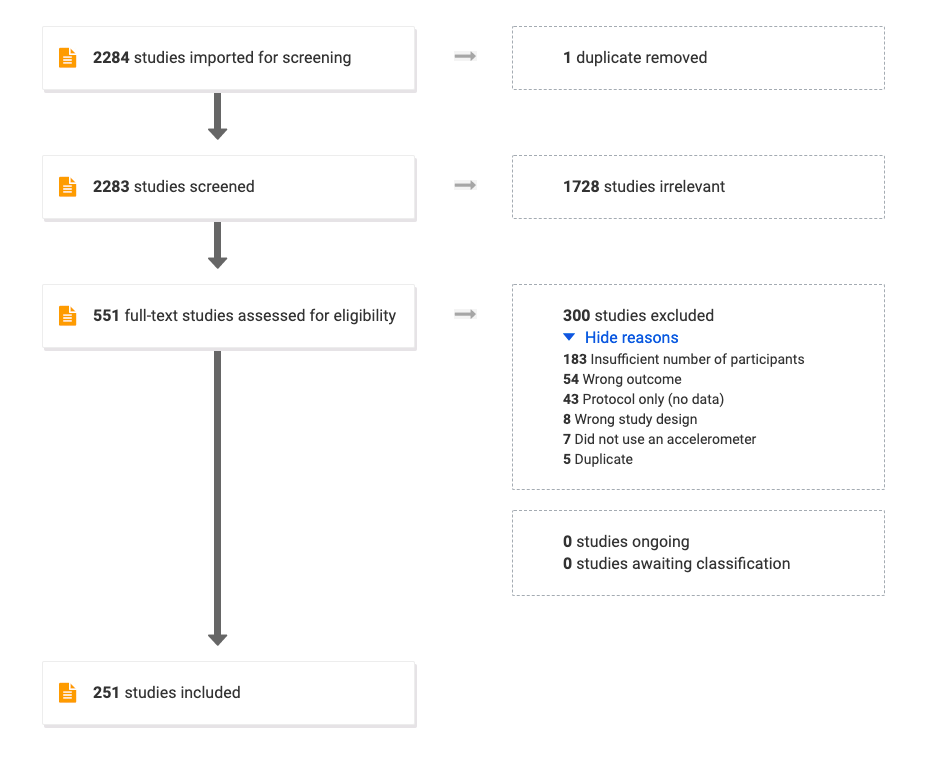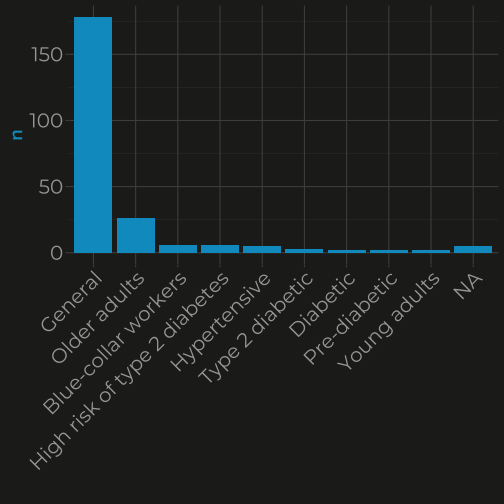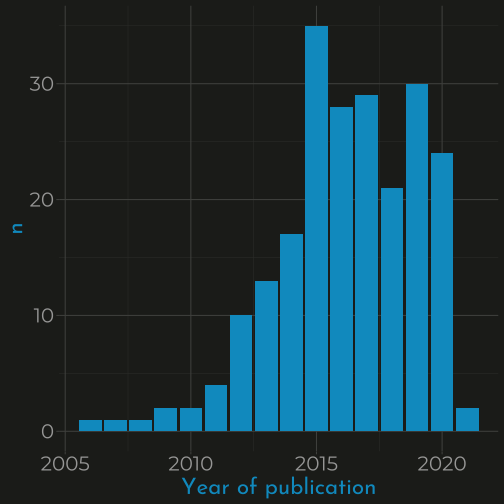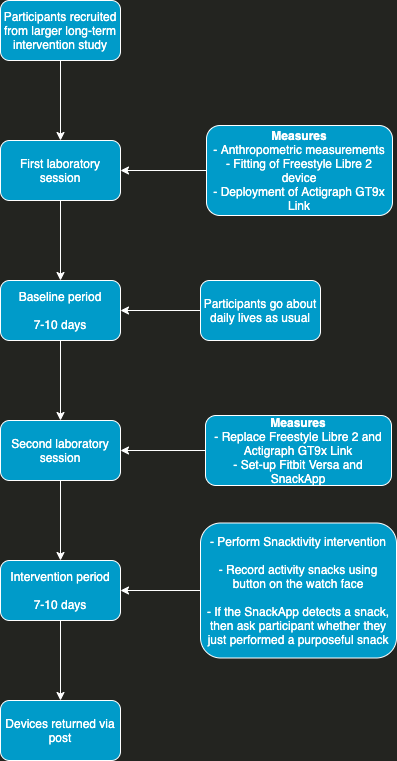The health benefits of Snacktivity in currently inactive individuals
Jonah Thomas
Presented on 15-06-2021
Last updated on 2021-06-15

Who Am I?
Background
First came to loughborough in 2015 to study Sport, Exercise and Health Science BSc
MSc in Exercise as Medicine
Research assistant in Digital Health Technologies
Second year PhD student within Snacktivity
Research interests:
Measurement of physical activity and sedentary behaviour
Digital Health Technologies
All things data science
Contents
Rationale for Snacktivity
Study plan
Accelerometer-measured physical activity datasets: A cross-country scoping review
The effects of activity snacks on cardiometabolic health outcomes: a harmonised compositional isotemporal substitution data-analysis
The acute effect of activity snacks on glucose control in currently inactive individuals: a wild experiment and comparison to background activity
The longer term affects of Snacktivity on cardiometabolic health outcomes
An open offer...
Rationale
The evidence suggests the volume of physical activity is more important than how this activity was accumulated when considering health outcomes
This led to changes in the four widest reaching physical activity guidelines allowing individuals to achieve 150 minutes per week of MVPA in bouts of any duration
Therefore, for those that are not currently meeting the physical activity guidelines, short bouts could be promoted as a means to increase the amount of MVPA they perform each week
Some activity snacks?


Study 0: Accelerometer-measured physical activity datasets: A cross-country scoping review
Rationale
Accelerometers have been used frequently to quantify movement behaviours over the last 2 decades
This has led to a large number of datasets collecting a range of health outcomes and physical activity metrics
However, there is currently no central library that has cataloged the available datasets
This is in spite of a highly successfully harmonised dataset of similar data in children (ICAD) and several notable harmonised data analyses: Ulf Ekelund and more recent Sebastien Chastin
Therefore, we will perform a scoping review to identify datasets that could be harmonised (both for our harmonised data analysis) and to serve as a library for other researchers.
- It will also update the review conducted by Katrien Wjindaele published in 2015
Aims/Objectives:
To inform the harmonised data analysis by highlighting the studies that have collected data as well as inform the ease of harmonisation of these studies
To create a library of datasets to serve as a resource to other academics who may be interested in performing secondary analysis or data harmonisation
Search strategy
Peer-reviewed online literature databases: Medline and Medline in-progress, EMBASE, CINAHL, Sport Discus and Central
Grey literature sources: Trials Registries, Open Grey and Conference Proceedings Citation Index-Science (CPCI-S)
Experts in the field will also be contacted to contribute “emerging” datasets
Forward and backward searching
Selection criteria
| Inclusion | Exclusion |
|---|---|
| Observational or trials based study design | Non-human population |
| Adult population | Only measure sleep |
| Measure physical activity using an accelerometric device | |
| Published in any language |
The first screening

Full-text: 2284
Selection criteria (updated)
| Inclusion | Exclusion |
|---|---|
| Observational or trials based study design | Non-human population |
| Adult population | Only measure sleep |
| Measure physical activity using an accelerometric device | |
| Published in any language | |
| Sample size greater than 400 | |
| Measured at least one cardiometabolic health outcome |
The second screening

(Draft) Results

Demographics
| Average number of participants | Total number of participants | Average age of participants | Percent male | Percent female |
|---|---|---|---|---|
| 3555 | 860289 | 56 | 46 | 55 |
Populations

Papers by Year

Datasets Identified
Study 1: The effects of activity snacks on cardiometabolic health outcomes: a harmonised compositional isotemporal substitution data-analysis
Rationale
Current evidence from epidemiological studies show the benefits of short bouts of MVPA on cardiometabolic health outcomes
Many of these studies use homogeneous datasets, and often the same dataset (NHANES 2003-2006)
- Due to cultural differences, some populations may be performing a greater number of activity snacks
- The health benefits of activity snacks may differ based on demographic characteristics that are rarely examined (ethnicity, physical activity profile)
Therefore, we will perform a harmonised data analysis on a diverse pool of studies and will perform compositional isotemporal substitution analysis to assess the health benefit of substituting sedentary time and bouted MVPA with activity snacks
Aims/Objectives:
To determine whether substituting sedentary time with activity snacks results in an improvement in cardiometabolic health outcomes
To determine whether substituting bouted MVPA with activity snacks results in any changes in cardiometabolic health outcomes


What is compositional isotemporal substitution analysis (cISM)
Examining multivariate data that forms part of a finite whole
Multiple variables that when combined will reach a known whole
sleep + sedentary time + LPA + MVPA = 24 hours
By treating time-use as part of a whole, we can model the expected effect of replacing one behaviour with another
- We plan to model substituting sedentary time and bouted MVPA with activity snacks
For more information, Dumuid et al provide an excellent summary of the origins and current directions of cISM analysis.

Next steps?
Finish data extraction
- Should be finalised in the next few weeks
Begin write up and produce first draft
Prioritise which datasets to seek access to for the harmonised data analysis
Study 2 and 3: Interventions exploring activity snacks

Study 2: The acute benefits of activity snacks on cardiometabolic health outcomes
Rationale
Several studies have examined the acute benefit of breaking up prolonged sedentary time with short bouts of physical activity on glucose control
- MVPA as short as 32 seconds can produce a beneficial acute response
However, even the most sedentary individuals (unless infirm) do not sit continually for 8-12 hours a day
Whilst the laboratory setting is beneficial for highly controlled conditions, it is not representative of how an individual goes about their normal life
Therefore, we will examine the acute benefit of activity snacks on glucose control during individual's usual daily routine

Aims/Objectives
- To determine whether the Snacktivity intervention leads to individuals performing a greater number of activity snacks when compared to their usual routine
- To assess whether performing purposeful activity snacks produce an additional health benefit when compared to an individual’s usual routine
To determine whether purposeful activity snacks produce a different acute cardiometabolic response to activity snacks performed as part of an individual’s daily routine
To assess participants perception of non-purposeful activity snacks and determine whether they are the similar to the perception they have of purposeful activity snacks
To assess whether movement differences exist between purposeful vs non-purposeful snacks and could these be utilised to refine the definition of an activity snack
Study 3: The longer term impact of activity snacks on cardiometabolic health outcomes
Rationale
Previous cross-sectional studies highlight that performing bouts of MVPA less than 10 minutes in duration are associated with improved cardiometabolic health outcomes including BMI, HDL and LDL cholesterol and blood glucose.
However, few studies have looked to assess whether if increasing inactive individuals physical activity by utilising short bouts of MVPA will lead to longer term improvements in cardiometabolic health
The main Snacktivity trial is not collecting a comprehensive battery of health outcomes
Therefore, we will look to determine whether the Snacktivity paradigm increases the number of activity snacks an individual performs and whether this increase is associated improvements in cardiometabolic health

Aims/Objectives
To determine if the Snacktivity intervention leads to individuals performing a greater number of activity snacks
To determine whether performing a greater number of activity snacks leads to changes in markers of cardiometabolic health
What next?
Finish data extraction and begin write-up of the scoping review
Begin acquiring datasets for the harmonised data analysis
Finalise protocols for the intervention studies and begin submitting ethics for both intervention studies
An open offer...
I might be able to help ...
I am experienced with:
- R
- SQL
- Federated data analysis systems
- Python (a little...hopefully more soon)
I am interested in:
- Data modeling
- Software development
- Data visualisation
- Anything a bit out there, different or challenging

Data Analysis and Visualisation

Shiny Apps

FormR
- A survey framework that allows the creation and management of highly complex survey designs
- Entirely open-source (Free!) and coded in R meaning anything you can do in R (which in my opinion is endless!) can be used in a survey

- More information can be found on the FormR Website
Automatically Generated Reports

Automatically Generated Reports

Want to see more?
- Find my blog at https://jonahthomas.netlify.app/ or feel free to drop me an email at j.j.c.thomas@lboro.ac.uk

 For more examples visit
For more examples visit 
